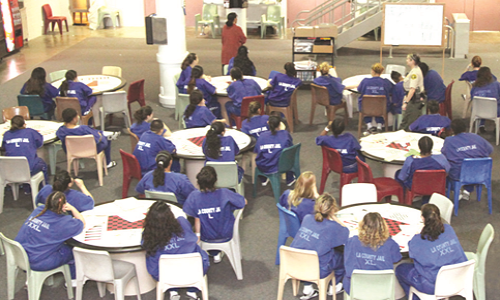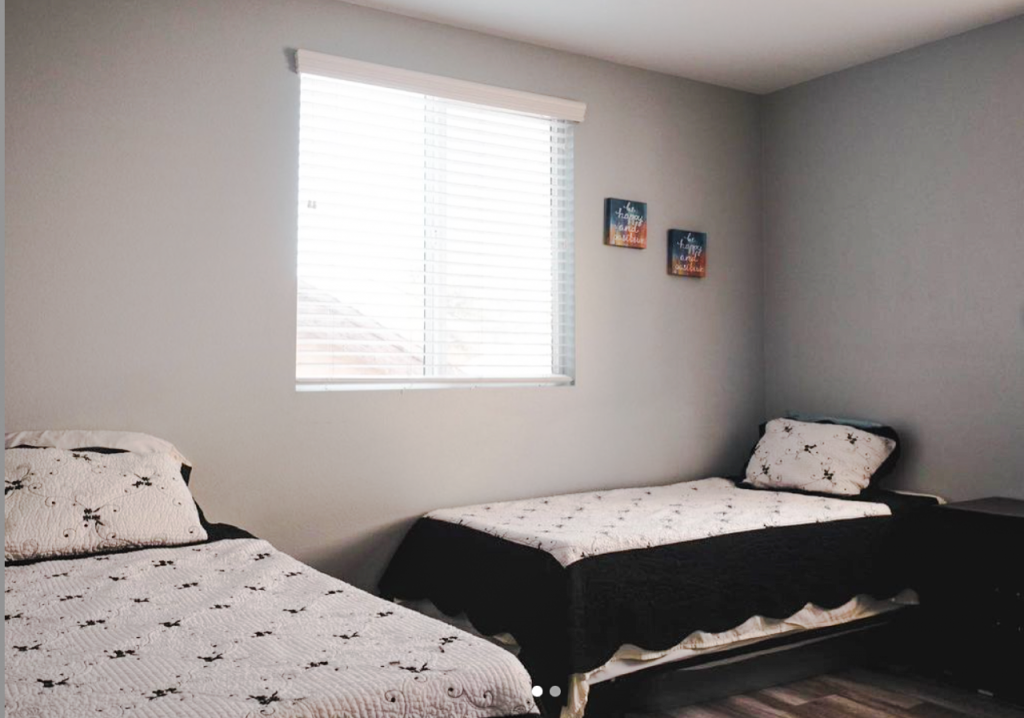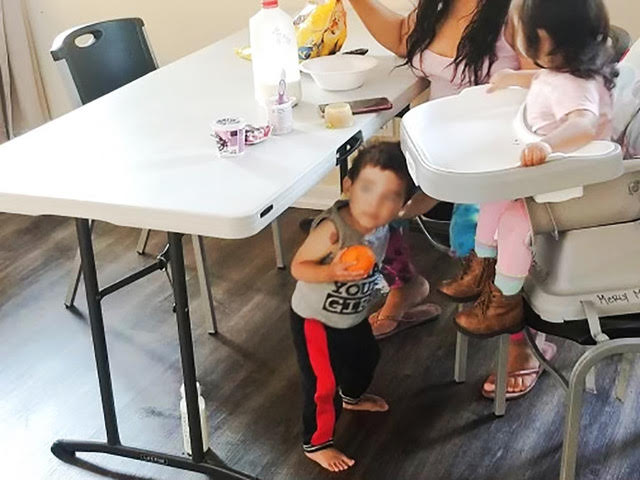In the second part of this multi-part series, we explore, step-by-step, the process for diverting pregnant people out of LA County’s women’s jail, moving them into housing and toward independence.
(If you haven’t already read Part 1 of Pregnant Behind Bars, read it here.)
The process begins with a list of names.
Every few days, the obstetrics team inside Los Angeles County’s main women’s lockup, the Century Regional Detention Facility, sends the county’s Office of Diversion and Reentry (ODR) a roster of pregnant people currently held in the facility.
ODR, which was launched in 2015, operates an array of programs meant to help people more successfully reenter the community from jail, as well as programs that divert people away from jail and into community-based care.
One such program, the Maternal Health Diversion Program, added to the ODR line-up in 2018, is focused on reducing the incarceration of the county’s pregnant people.
The first thing, Casey Nairin, head of the Maternal Health Diversion Program, does after receiving the latest list of jailed pregnant people, is to find out the nature and seriousness of the criminal charges a woman is facing.
The case information and arrest reports help Nairin determine whether to take the next step, which is to meet with the woman and discuss with her and her attorney whether she is interested in participating.
So who are the women who generally take part in the diversion program?
While the ODR does not yet have the resources to gather the data needed to fully answer that question, a soon-to-be-released report from the Chief Information Office, a division of the LA County Chief Executive Office, offers some partial answers. The report authors have analyzed those who entered diversion while they were in the pre-trial phase of the criminal court process, which represents 15 percent of the Maternal Health Diversion population.
Within that slice — which is a reasonably accurate representation of the whole Maternal Health population, according to ODR’s medical director, Dr. Kristen Ochoa — 21 percent are identified as chronically homeless, and 43 percent are reported to have a serious mental health diagnosis.
In terms of race, around 11 percent of the pre-trial participants are white, 21 percent are Black, 64 percent are labeled as Hispanic, and 4 percent are “unknown.”
A 2019 Million Dollar Hoods report analyzing the women in LA’s jails between 2010 and 2016 by race and by charges, revealed similar racial disproportionalities as those of the upcoming CIO report.
Casey Nairin heads to jail
As she enters the jail with her list of potential clients, Casey Nairin is greeted by shouts of “Miss! Miss!” from pregnant people hoping to speak with her about their cases.
Nairin’s name and what she does for a living is information that is passed around among women in the jail’s medical housing, along with the news that you can’t apply for admittance into ODR’s special program for pregnant people. Nairin has to come to you.
When Nairin meets with a woman inside the jail, she tells her prospective client about the program, gauges her interest, and asks a series of questions to gather background information, potential needs, and other pertinent life details.

If a pregnant person agrees to diversion, Nairin and the ODR team then work with the relevant prosecutor and judge to get the case transferred into the county’s special diversion court, run by Judge Karla Kerlin.
As we mentioned in Part One, program leaders do not attempt to divert people accused of murder or attempted murder, and some other serious crimes. That said, the diversion program is not just for individuals accused of low-level crimes.
According to the CIO’s report on the pre-trial Maternal Health population, 61 percent of those participants are convicted of felonies, and 39 percent are convicted of misdemeanors upon their entry into the program.
The diversion team assesses serious charges on a case-by-case basis, carefully considering a list of variables.
Things can get further complicated, Nairin’s predecessor, Aubrey Lovelace, said, when a person’s bail is really high or if they have a lot of co-defendants, as can be the case with gang-related charges.
Numbers and gatekeeping
As the program has progressed from its 2018 inception, the number of pregnant people behind bars on any given day has dropped significantly.
Starting in 2019, the LA County Sheriff’s Department began reporting pregnant individuals as a subpopulation in the department’s custody reports. That year, there was an average of 44 pregnant people in LA’s women’s jail each day.
By the first quarter of 2021, the daily average was down to 18 pregnant people in CRDF.
That change may be, in part, an artifact of the pandemic, but ODR leaders credit their program for much of the progress toward reducing incarceration rates for LA’s pregnant people.
During a phone call in February, Judge Peter Espinoza, ODR’s director, read aloud to WitnessLA from a weekly jail report prepared by his team.
Just one of 18 pregnant women in CRDF had charges too serious to attempt diversion, he said.
But there were other cases ODR could not touch, for various reasons. One woman had already been sentenced to state prison, and was awaiting transfer. Another woman’s case was pending extradition to a different state or jurisdiction. A third refused diversion altogether. A fourth pregnant person was declared incompetent to stand trial.
This last individual, however, may qualify for one of ODR’s other diversion programs tailored to help people with serious mental health issues, including those who have been found legally unfit for trial.
Eight people on the list were new arrivals to the jail meaning the LA Sheriffs would not make them available to the ODR staff for interviews until the following week. Another name on the list of potentials was that of a previous diversion participant who had been arrested again.
Only one of the 18 was to be released to ODR that same day. Three more were in ODR’s pipeline for potential diversion — meaning that ODR was in conversation with the women and their lawyers to determine whether they wanted to participate in the diversion program.
In most cases, the answer to that last question is an emphatic “yes.”
The enthusiasm is not unexpected.
The Lynwood-located facility is a grim and sometimes dangerous place to be, made worse by having to experience the jail while pregnant.
“It is so hard to be in jail,” an MHD participant, Bernadette Campos said. “Nobody realizes the shit you go through.”
“You can’t just go in there and be a bookworm,” she said, describing jail as stressful and chaotic. “There are fights in there daily. Someone will fuck with you somewhere along the line.”
Campos said she often worried that another incarcerated woman might harm her while she slept.
The mothers we interviewed shared stories of sleeping uncomfortably on thin mattresses under scratchy blankets, of not being allowed to shower regularly enough, of having to eat food that was far from nutritious, especially for someone carrying a baby, and of feeling hungry when they didn’t have money for supplemental food from commissary.
Some mothers described experiences far more distressing than the day-to-day indignities and discomforts of jail while pregnant.
(We’ll get to those issues in an upcoming chapter of the series.)
Once Nairin receives the okay from a woman and her attorney, the attorney reaches out to the prosecutor on the case to see if the DA’s office is willing to consider a diversion program.
If they and the criminal court judge agree, said Nairin, “the judge will have the woman plead guilty to the charges.” Sometimes this part of the court process can take months, especially if, for one reason or another, a judge in another municipality outside of the LA Superior Court system is loath to let a woman’s case go.
Once the case is transferred to Judge Kerlin’s diversion court, however, Kerlin serves as the final gatekeeper, making the ultimate decision whether or not to sentence the candidate to probation, “specifically ODR Maternal Health probation,” said Nairin.
Everything you want to have while you’re pregnant
Once approved for diversion, the women are released into ODR’s care.
New ODR clients are taken temporarily to a motel-like reception center before ODR places them into congregate housing sites run by various community-based organizations (CBOs), the most prominent of which is a CBO called Holliday’s Helping Hands.
ODR and the partner organizations work to ensure residents of the interim housing have as warm and homey an environment as possible, Nairin said, a strategy that, according to the women WLA interviewed, makes a big difference in their state of mind.

“Everything is so clean. It’s so neat. It’s so not a facility,” Leslie Garcia said about moving into ODR’s housing. “Your room, your bed, your mattress, just, everything is what you want to have while you’re pregnant, what you want to have in your home.”
A look around Holliday Helping Hands’ houses reveals art prints featuring upbeat sayings like, “Be happy and positive,” and, “It is so good to be home,” printed in swirling cursive, along with more practical wall decor, such as lengthy reminders of the house rules.
While Garcia and her daughter had their own bedroom, most share rooms with other moms and babies in the multi-bedroom houses, which are set up to care for more than a dozen women at a time.

The program takes individuals who chose to terminate their pregnancy, but ODR leaders told us that most choose to give birth.
Once the baby arrives, the mother will have full support, Garcia said. Women are encouraged to get plenty of rest, “and the food is good and healthy.”
Some of the mothers have other young children who are also able to come live with them inside the housing.
While it’s less common, the program will take women who have supportive families and stable housing waiting for them on the outside, as long as the diversion court judge agrees to such an arrangement.
Women who go home still have access to the program’s support system, but it’s sometimes harder for case managers to keep track of those who aren’t living in ODR housing, Nairin told WLA.
Case managers at the core of mothers’ support system
Every resident receives a case manager, each of whom has a caseload of 15 clients, according to Chapawnie Forbes, a former case manager who spoke with WLA.
The case managers, who are provided through one of ODR’s community-based partner organizations, Project 180, are deeply engaged in the lives of their clients, helping them navigate their mandatory probation, and other program requirements, along with the many complexities of their daily existence.
Case managers help mothers access mental and physical health care, and treatment for substance use disorder, if needed. Case managers are also required to step in and assist if mothers have open child welfare cases with the LA County Department of Children and Family Services (DCFS).
“I related to all of my clients, because I’m a mom as well,” Forbes said.
“Empathizing with them and being very personable and understanding, really showing them that you’re on their side and you’re there to help them,” she said. “All those things go a long way.”
Still, to be a good case manager, Forbes said, “you have to have thick skin.” Most of the mothers “come from so much trauma.” And some of the women, “are a little bit harder to deal with than others.”
The most painful thing to see, according to Forbes, was the occasional case in which DCFS removed children from their mother’s care.
One client, “was doing very well” after recently being transferred to Forbes’s caseload. “She had her kid, had her own place.” Yet, “for one reason or another DCFS came, and took the kid.”
She thought, she said, that DCFS stepped in because the woman already had two kids taken from her by child welfare. The mother was shattered. “After they took the baby, she relapsed.
“And it was a downward spiral from there.”
A place of their own
Before participants can move out of the group home and into their own apartments, they have to check off the requirements of a “housing ready list.”
These requirements include participating in Project 180-run groups focused on parenting, sex and healthy relationships, and relapse prevention. They must also test negative for drugs and have full compliance when it comes to taking any medications prescribed to them. In addition, there must be no major recorded issues or incidents with the housing site staff, or with those involved in their treatment plan, including their case manager, therapist, and psychiatrist.
Once program leaders determine a client is stable enough to move out on their own, which usually occurs between six months and a year into the diversion program, the mother and housing coordinators begin looking for apartments.
The process can take time, several mothers told us, particularly LA’s wild and costly COVID-affected housing market.
Although the program was helpful, the mothers said, they did much of the footwork themselves, in the hope of getting into housing more quickly. They looked online for available housing, and drove around if they had cars scanning various promising neighborhoods for rental signs. Some said they even called property management companies to see if they would accept rent payments from the diversion program.
Once an apartment is secured, ODR equips the space with essential furniture, food, and other house supplies.
“When I got here, it was furnished for me,” said Leslie Garcia. “My son has his own room. I have a walk-in closet, and my restroom is humongous. And, I mean, I came from zero.”
ODR pays for nearly everything as participants transition from jail, to congregate housing, to living on their own. Mothers are expected to cover manageable payments once they enter independent housing until they are ready to be self-sufficient.
Diversion participant, Michelle Loest, told us that she’s required to pay one-third of her income — a little over $200 — toward rent.
Two other mothers who had officially completed probation and the diversion program told us that ODR was in the process of transferring them over to receiving assistance through the federal Housing Choice Voucher Program, also known as Section 8, which subsidizes housing for low-income individuals and families.
If they want it, mothers can still receive help from ODR after they have completed their probation terms and, thus, officially graduated from the diversion program.
Paying to house and help those who have been justice system-involved takes considerable county funding. ODR leaders have reported that it costs about $70 per day per diversion participant.
Yet, justice advocates point out that it is far cheaper than incarcerating those same people.
According to the Million Dollar Hoods report about incarcerating women in Los Angeles County, the county spent a little over $115 per day to lock someone up in LA’s jails in 2016. And incarcerating individuals in a state prison is even more costly, reaching $279 per day in California, in 2021.
This cost comparison does not take into account the considerable amount of cash that diversion and reentry services save taxpayers by reducing the likelihood that a person will return to jail and/or prison in the future, thus removing those same people from active parenting and from contributing to their communities.
Michelle Loest, Leslie Garcia, and the other mothers WLA spoke with all emphasized how much ODR’s program helped them and their children.
The security of stable housing, said Loest, can be life-changing.
“You don’t struggle financially because of this program.” That’s a huge relief, she said, “because a lot of the things that I was doing, I was doing because I needed money.”
Now, said Loest, she feels that her opportunities are limitless.
“I know I could go back to school,” she said, then confided that she’d like to study to become a paralegal.
Seeing mothers make it into independent housing with their families is a wonderful experience, former case manager Chapawnie Forbes told WLA.
“They’re coming from jail,” she said, “and from so much trauma. To see them working, taking care of multiple kids in their own home, living independently, and being successful at it — it’s very transformative,” Forbes said.
“You just feel so proud — proud of them mostly, because they’re the ones really putting in the work,” said Forbes.
“At the end of the day, it’s their lives. We’re just there to support them.”
Yet, as Forbes suggested, the process is not without setbacks, which can be heartbreaking and complicated.
Watch for Part 3. You’ll want to read it. We promise.
This series by WitnessLA’s assistant editor, Taylor Walker, was produced as project for the USC Annenberg Center for Health Journalism’s 2021 California Fellowship.
Featured image: Dining area inside the Maternal Health Diversion Program’s interim housing.
Correction: This story originally identified Casey Nairin as the director of the Maternal Health Diversion Program. To clarify, while Nairin does lead the program, her title is Maternal Health Program Manager.

